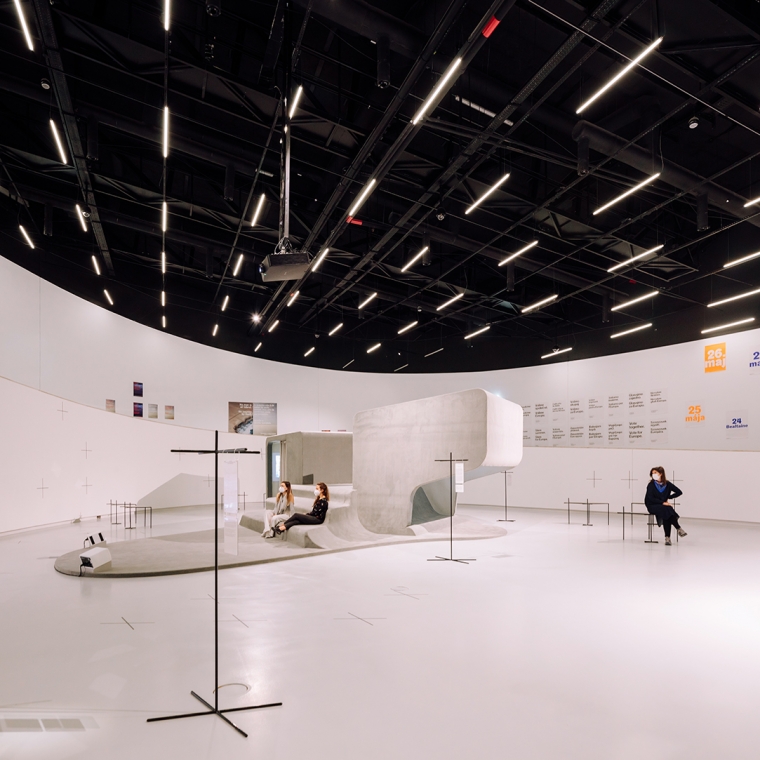Battles in a Future Estate
by Ala Younis
Cinematic Architectures [with]in Arab Geographies is a series of three online lectures, curated by Róisín Tapponi, that focus on the role of the contemporary moving image and the production of space. "Battles in a Future Estate", by Ala Younis, is the first proposition in this series.
In 2006, US military intelligence cameras recorded the movements of American soldiers during the Battle of Haifa Street in Baghdad in Iraq. While soldiers were breaking into the apartments of high-rise buildings or hiding behind arches, the city’s contemporary landmarks appeared in the background of the images of the streets where Iraqi fighters were stationed. The houses that were broken into had never been exhibited in this way before, even though their plans had been shown in international magazines when they were designed by international architecture firms in the eighties. Several artists also created five paintings each for the entrances to the offices and housing blocks, and monuments for the public spaces. This decade witnessed a wealth of architectural and artistic talent focused on envisioning and engaging with the ideal city whose work was commissioned by the same regime that these architects and artists would attempt to escape from at the end of that decade and at the turn of the new century.
The architecture in Haifa Street was a conceptual prototype, a demonstration of the possibilities of a unique aesthetic discourse whose influence would seep, with its architects, from Baghdad to the rest of the region. The housing blocks were named after the nationality of the companies contracted to build them, and the blocks were entirely dedicated to a single type of resident. The 540 Dutch apartments were allocated to academics, the 400 German apartments were allocated to Syrian dissidents who had taken refuge in Iraq, and the buildings in the first part of the project were allocated to government employees.
The art portraying Saddam Hussein in the Saddam Arts Centre, which stands in the middle of Haifa Street, covered almost the entire ground floor. The art in his palaces and scattered across the country were replicas of his face, and it is perhaps because of the appearance of this art in the street that the US military became convinced of its residents’ loyalty to the regime in 2003. The American cameras not only filmed their soldiers’ attacks but also depicted the residents in a single light – as terrorists.
Some of the academics who lived in the Dutch apartments resettled in other places in the region – Amman, Dubai and other cities – where they either teach or continue to practise the same architectural vision that was developed in/for Haifa Street. Today, pictures of these houses can be found on many real estate websites, allowing us to imagine how much it would cost to own one in a slowly recovering Baghdad.
This presentation will attempt to single out mono-cultural practices and strategies as they inform military, artistic and architectural images. It will also attempt to historicise the fragmentation that inform these testimonies.
|
Curated by Aric Chen, with Martina Muzi, X is Not a Small Country – Unravelling the Post-Global Era includes nine newly created projects by international practitioners working across the fields of design, architecture and art who investigate, articulate and critique the current convoluted state of the world from multiple geographic perspectives. |
Cinematic Architectures [with]in Arab Geographies is a series of open-ended online talks on maat ext. that focus on the role of the contemporary moving image and the production of space. The conversations are grounded within the contested borders of the so-called “Arab region”, and explore how human geographies, urban governance and architectural environments function in situ. Róisín Tapponi, curator of the cycle of films programmed to respond to the work Tactile Cinema (2021) by Bricklab, in the context of the exhibition X is Not a Small Country invites the prominent architectural and cinema researchers Ala Younis, Nora Akawi and Helene Kazan to navigate this terrain. This programme is a collaboration between maat and Art Jameel. |
-
Excerpt from the video of Ala Younis' lecture.
|
Ala Younis is an artist who trained as an architect in Amman. Her practice focuses heavily on research as well as curating, collaboration, film, and book projects. Her projects deal with collective experiences that collapse into personal ones, and with how archives play on predilections and their lacunas and mishaps manipulate the imagination. Her work has been featured in shows in Amman, London, Seville, Sharjah, Dubai and New York. She has also taken part in “Home Works: A Forum on Cultural Practices”, Beirut; the Istanbul and Gwangju Biennials; and the New Museum Triennial, New York. Her work Plan for Greater Baghdad (2015) premiered at the 56th Venice Biennale. In 2018, she reproduced the timeline for the same project but from a female perspective, with the title Plan (fem) for Greater Baghdad. In 2013, she curated Kuwait’s first national pavilion at the 55th Venice Biennale and co-founded the publishing initiative Kayfa ta. She is a member of the Advisory Board of Berlinale’s Forum Expanded and of the Akademie der Künste der Welt, Cologne. She co-curated How to Reappear: Through the quivering leaves of independent publishing at Beirut Art Center in 2019. |
Róisín Tapponi is an Iraqi-Irish curator, film programmer, researcher, archivist and writer. She is the founder and programmer of Habibi Collective and has curated regional film festivals, including the Independent Iraqi Film Festival and the Queer Mena film festival. Tapponi has curated screenings at international institutions such as Sharjah Art Foundation and MoMA, and has been lecturing on cinema at various academic institutions, including Oxford University and Duke University. Currently, Tapponi is developing an independent streaming service for Middle East and North African cinema, Shasha Movies. She is also founder and editor of ART WORK Magazine, a critical art magazine for cultural workers operating on the margins. |








